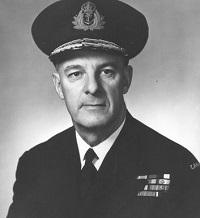Canada's First New Arctic Patrol Vessel Launched
The future HMCS Harry DeWolf, the first of Canada's new Arctic and Offshore Patrol Vessels to be built, was launched in Halifax Harbour on Saturday.
At 103 meters (338 feet) and 6,615 tons, Harry DeWolf is the largest Royal Canadian Navy ship built in Canada in 50 years. The lead ship in the program is now pier side at Halifax Shipyard where Irving Shipbuilding will continue working to prepare the ship for sea trials in 2019. Harry DeWolf is scheduled to be turned over to the Royal Canadian Navy in summer 2019.
Construction of the second and third ships, the future HMCS Margaret Brooke and Max Bernays, is underway at Halifax Shipyard. Later this month, the first two major sections of Margaret Brooke will be moved outside.
In total, there will be six ice-capable ships, designated as the Harry DeWolf Class, after Canadian wartime naval hero Vice-Admiral Harry DeWolf (biography below).
The new vessels, with a complement of 65, will be capable of armed sea-borne surveillance, including in Canada’s Arctic; providing government situational awareness of activities and events in the region.
Canada's National Shipbuilding Strategy was established to replace the current surface fleets of the Royal Canadian Navy and the Canadian Coast Guard. Irving Shipbuilding was selected to construct the Royal Canadian Navy’s future combatant fleet—Arctic and Offshore Patrol Vessels followed by Canadian Surface Combatants.
Harry DeWolf Class Vessel Features:
• Modern integrated bridge, from which control of navigation, machinery, and damage control systems can be performed.
• Multi-Purpose Operational Space where operational planning and mission execution will be coordinated.
• BAE Mk 38 Gun: Remote controlled 25 mm gun to support domestic constabulary role.
• Enclosed Focsle/Cable Deck protects foredeck machinery and workspace from harsh Arctic environment.
• Helicopter Capability: Depending on the mission, the embarked helicopter could range from a small utility aircraft right up to the new CH-148 maritime helicopter.
• Cargo/Payloads: Multiple payload options such as shipping containers, underwater survey equipment, or a landing craft. Ship has a 20-ton crane to self-load/unload.
• Vehicle Bay: For rapid mobility over land or ice, the ship can carry vehicles such as pickup trucks, ATVs, and snowmobiles.
• Diesel/Electric Propulsion: Propulsion: two 4.5 propulsion MW (induction) motors, and four 3.6 MVA generators.
• Retractable Active Fin Stabilizers deployed to reduce ship roll for open ocean operations, retracted for operations in ice.
• Multi-Role Rescue Boats: Top speed of 35+ knots, 8.5 meters (28 feet) long. Will support rescues, personnel transfers, or boarding operations.
• Bow Thrusters to enable maneuvering or berthing without tug assistance.
Biography: Vice-Admiral Harry George DeWolf, CBE, DSO, DSC, CD (Source: Royal Canadian Navy)
 Vice-Admiral Harry DeWolf was born in Bedford, Nova Scotia in 1903 and joined the Royal Canadian Navy as a cadet in 1918 to attend the Royal Naval College of Canada in Esquimalt, British Columbia. From 1921 until 1925, he conducted his training with the Royal Navy on the battleship HMS Resolution followed by training courses with the Royal Navy, as well as service at sea with the Royal Navy and the Royal Canadian Navy (RCN). In 1928, he specialized in navigation, attending the Long Navigation Course at HMS Dryad in England, followed by further seagoing and staff appointments with both the Royal Navy and the RCN.
Vice-Admiral Harry DeWolf was born in Bedford, Nova Scotia in 1903 and joined the Royal Canadian Navy as a cadet in 1918 to attend the Royal Naval College of Canada in Esquimalt, British Columbia. From 1921 until 1925, he conducted his training with the Royal Navy on the battleship HMS Resolution followed by training courses with the Royal Navy, as well as service at sea with the Royal Navy and the Royal Canadian Navy (RCN). In 1928, he specialized in navigation, attending the Long Navigation Course at HMS Dryad in England, followed by further seagoing and staff appointments with both the Royal Navy and the RCN.
In 1939, then Lieutenant Commander DeWolf assumed command of the destroyer Her Majesty’s Canadian Ship (HMCS) St. Laurent and participated in Atlantic convoy escort duties, as well as the evacuation of troops from France in 1940. He was Mentioned in Dispatches twice (a national honor for distinguished service) for his leadership in command.
In 1943, Commander DeWolf assumed command of the Tribal-class destroyer HMCS Haida, a ship that would come to define his legacy as a warrior. Haida was known as the “Fightingest Ship in the Royal Canadian Navy.” During his 14-month tenure as commanding officer, Haida played a role in the destruction of more than a dozen enemy vessels, including three destroyers and a submarine. He was awarded the Distinguished Service Order for gallantry, the Distinguished Service Cross for courage and skill in action against German destroyers, and two more Mentions in Dispatches for bravery, courage and determination.
A consummate leader both ashore and afloat, his exceptional wartime service was recognized with an appointment as a Commander of the Order of the British Empire, and an Officer of both the United States Armed Forces Legion of Merit and the French Legion of Honour. He also received the French Croix de Guerre and the King Haakon VII Liberty Cross from Norway.

that matters most
Get the latest maritime news delivered to your inbox daily.
Following the war, he continued to excel, commanding the light aircraft carriers HMCS Warrior and HMCS Magnificent. In 1948, he was promoted to Rear-Admiral and in 1952, he was appointed Principal Military Adviser to the Canadian Ambassador to the United States and Chairman Canadian Joint Staff in Washington, D.C. In 1956, upon promotion to the rank of Vice-Admiral, he was appointed Chief of the Naval Staff where he served until his retirement in 1960.
Vice-Admiral DeWolf passed away in Ottawa on December 18, 2000, and his ashes were scattered at sea from HMCS Ville de Québec in 2001.
